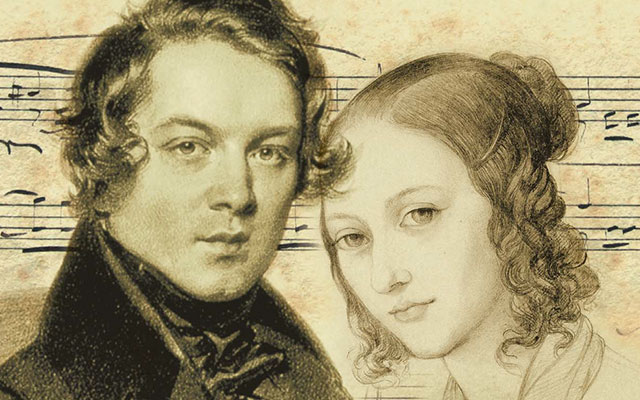Mercury explores Robert and Clara Schumann in song, dance and music

Mercury presented a dramatized musical program about Robert and Clara Schumann Saturday night at the Hobby Center for the Performing Arts in Houston.
The love story of Robert and Clara Schumann radiates poetry and pathos. Overshadowed by turmoil from the beginning, their romance inspired some of the 19th century’s most passionate music. But Robert’s mental illness and early death left Clara to spend nearly 40 years as a widow keeping the flame.
Hollywood latched onto the saga in the 1940s, casting Paul Henreid as Robert and Katharine Hepburn as Clara in the romance Song of Love. Houston’s Mercury period-instrument ensemble reclaimed the storied couple for the classical-music world Saturday in Houston’s Hobby Center for the Performing Arts.
Like Hollywood’s version, Mercury’s staged program “Loving Clara Schumann” included a third character from real life: Johannes Brahms, the young protege of the couple who grew smitten with Clara himself. The love triangle, as evoked in music by all three protagonists–including a few of Clara’s long-neglected compositions–gave “Loving Clara Schumann” its focus.
The scenario, by Mercury artistic director Antoine Plante and Houston stage director Tara Faircloth, sidestepped the actual story’s fraught beginnings, when Clara was only 15 years old and her father fought to squelch her and Robert’s relationship.
Instead, “Loving Clara Schumann” began with love in bloom. Clara had three incarnations: pianist Rachel Chao, mezzo-soprano Megan Samarin and dancer Genene McGrath. They wore identical costumes of blue skirts and white blouses, and sometimes all three were onstage at once.
The stage in Zilkha Hall, the Hobby Center’s smaller theater, would have become crowded quickly if Robert and Brahms also had appeared in triplicate. But fortunately baritone Lee Gregory and dancer Dwain Travis–like McGrath, a member of Houston’s METdance–each portrayed both Robert and Brahms in turn.
The key, if I correctly read what was happening onstage, was that whichever man wore the yellow scarf at the moment represented Schumann, and whichever had the green scarf was Brahms. Or maybe the scarves had to do with whomever Clara was most focused on.
In any case, Robert and Brahms couldn’t be portrayed in the same terms at the same time, and that diminished the production’s theatrical impact. When a scene centered on dancing, the choreography by METdance director Marlana Doyle couldn’t involve all three equally. After all, only one man was a dancer. When Brahms appeared on the scene as McGrath and Travis danced as Robert and Clara, singer Gregory could only step up and be awkwardly nudged away by Robert.
But the essential storyline was clear enough. Video projections by Faircloth and Ben Doyle also helped crystallize the stage of affairs. At the outset, roses and other verdant imagery evoked the springtime of Robert and Clara’s love. As Robert’s illness took its toll, the roses faded and trees grew bare.
Plante and Mercury’s string players, tucked in one corner of the stage, performed chamber works song accompaniments and even part of Brahms’ Symphony No. 3, transcribed by Plante.
The ensemble delivered movements from Robert’s First and Third String Quartets with grace and vigor as Doyle’s choreography brought his and Clara’s emotional situation to life. A lilting, affectionate scene centering on dancers McGrath and Travis showed Robert and Clara’s love in full force. When Robert’s mental illness flared, Travis hurled himself across the stage, embodying the disease’s torments.
Songs by Robert, Clara and Brahms also shed emotional light. Several excerpts from Robert’s Frauenliebe und -leben, the story of a woman in love, helped reveal Clara’s inner world, thanks to mezzo Samarin’s vocal generosity and warmth. In lieder including Schumann’s “Schöne Wiege meiner Leiden” and Brahms’ “Wir Wandelten,” baritone Gregory sang artfully, but his voice sometimes turned thin or shaky in the process.
After Schumann’s death, a bittersweet pas de deux for McGrath and Travis as Brahms unfolded to the Poco allegretto from Brahms’ Third Symphony. Brahms’ wistful excerpt worked surprisingly well in this condensation for a dozen or so strings.
But the most telling musical discoveries were the little-known works by Clara. Pianist Chao’s richness and assurance brought out the fervor in the Op. 6 Notturno, a rhapsodic work with kinship to music of both Robert and Chopin. Several of Clara’s melodious songs were scattered through the program. And the night closed with Samarin singing “Liebst du um Schönheit,” based on the same Friedrich Rückert poem set more famously by Gustav Mahler. Yet Clara’s version boasted a simple eloquence of its own.


